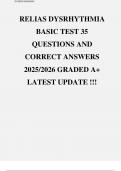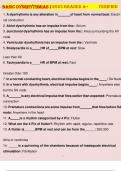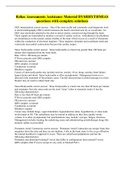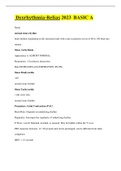Dysrhythmia
Liberty University
All 5 resultados
Ordenador por

-
RELIAS DYSRHYTHMIA BASIC TEST 35 QUESTIONS AND CORRECT ANSWERS 2025/2026 GRADED A+ LATEST UPDATE !!!
- Examen • 14 páginas • 2025
-
 Tutor23
Tutor23
-
- $8.99
- + aprende más y mejor
Sinus Bradycardia Regular Rate: <60 P Wave: Present, upright PR Interval: 0.12-0.20 sec QRS: <0.12 sec TUTOR23 RESOURCES Atrial Fibrillation IRREGULAR Atrial rate: UNMEASURABLE Ventricular rate: variable P wave: unable to see PR Interval: N/A QRS: <0.12 sec A 昀椀b RVR IRREGULAR Ventricular rate: 100-175 P wave: unable to see PR Interval: N/A QRS <0.12 sec

-
BASIC DYSRHYTHMIAS I 2023 GRADED A+ VERIFIED
- Examen • 17 páginas • 2024
-
 claytondoc
claytondoc
-
- $11.99
- + aprende más y mejor
1. A dysrhythmia is any alteration in of heart from normal beat: Electrical conduction 2. Atrial dysrhythmia has an impulse from the:: Atrium 3. Junctional dysrhythmia has an impulse from the:: Area surrounding the AV node 4. Ventricular dysrhythmia has an impulse from the:: Ventricle 5. Bradycardia is a HR of BPM at rest: Slow Less than 60 6. Tachycardia is a HR of BPM at rest: Fast Greater than 100 7. In a normal conducting heart, electrical impulse begins in the : SA Node 8. In a he...
QUESTIONS AND ANSWERS
QUESTIONS AND ANSWERS

-
Relias Assessments Assistance Material DYSRHYTHMIAS questions with complete solutions
- Examen • 5 páginas • 2023
-
Disponible en paquete
-
 Classroom
Classroom
-
- $10.49
- + aprende más y mejor
EKG interpretation correct answer: One of the most useful and commonly used diagnostic tools is electrocardiography (EKG) which measures the heart's electrical activity as waveforms. An EKG uses electrodes attached to the skin to detect electric current moving through the heart. These signals are transmitted to produce a record of cardiac activity. Arrhythmia or dysrhythmia are disturbances in the normal cardiac rhythm of the heart which occurs as a result of alterations within the conduction ...

Ese resumen que acabas de comprar ha hecho muy feliz a alguien. ¿También te pagan semanalmente? ¡Vende tus documentos de estudio en Stuvia! Descubre todo sobre cómo ganar en Stuvia




